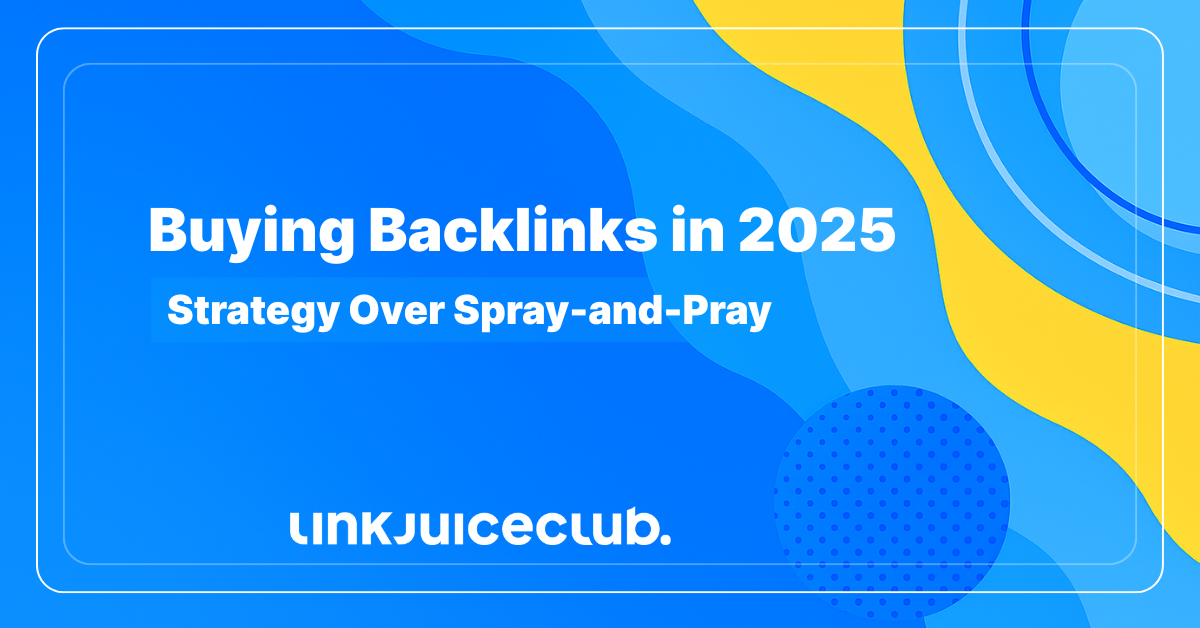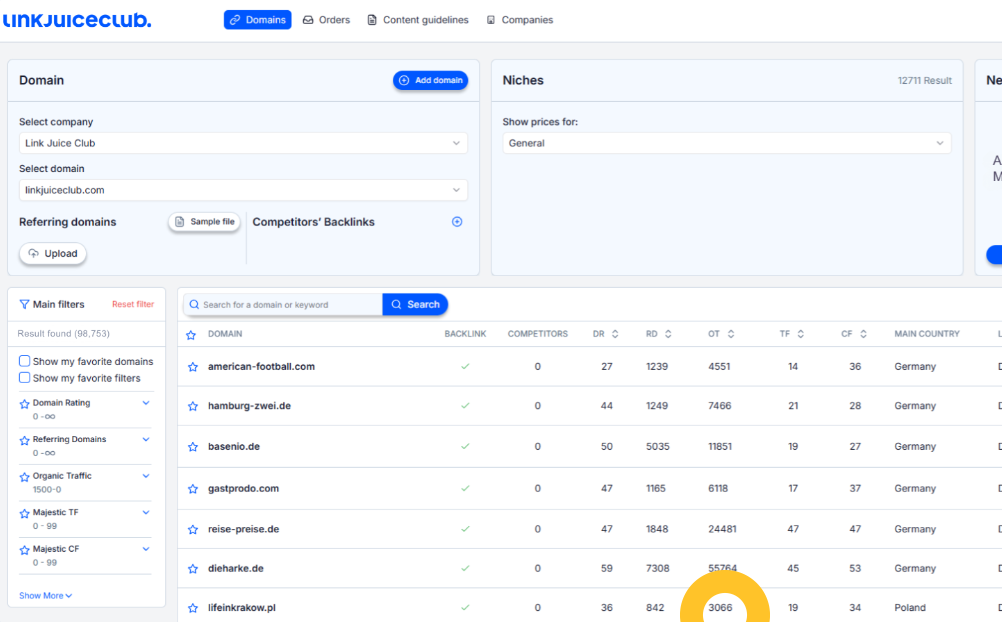
Buying Backlinks in 2025: Strategy Over Spray-and-Pray
Let’s get one thing straight: knowing how to buy backlinks isn’t some shady little secret anymore.
Everyone from solo hustlers to big-name brands is in on the game.
Agencies call it “outreach.”
In-house teams dress it up as “editorial partnerships.”
Affiliates? They’re all-in and unapologetic.
Despite Google’s endless sermons and spam-slap crusades, the truth’s been quietly screaming for two decades, backlinks still run the SEO show. Especially when the SERP battlefield gets bloody competitive.
But here’s where things fall apart… Most people are buying links like it’s still 2012. They are:
- Chasing DR like it’s gold dust
- Ignoring context and relevance
- Paying premium prices for junk placements
- Forgetting to track performance entirely
And then? An update rolls in, and boom, the rankings vanish like smoke.
We’re not here to peddle tired tactics or whisper “guest post” like it’s some underground spell.
This guide? It’s the grown-up playbook.
✅ We’ll break down metrics that do move the needle
✅ We’ll teach you how to layer and grow trust, not just links
✅ We’ll help you build a profile Google can’t easily shake down

Feeling lost in the lingo? No worries. We’ll break it all down step by step, starting now. 👇
What Is Link Buying Really All About?
Think of the process of trying to buy backlinks like hiring a PR team for your site. You’re not just paying for exposure, you’re paying to shape perception.
In plain terms? Link buying is the practice of paying for backlinks to increase your authority in Google’s eyes, and climb higher in search results.
But don’t get it twisted…
🚫 It’s not about buying clicks
🚫 It’s not about buying traffic
🚫 You’re definitely not buying a shortcut to Page 1
What you are buying, if done right, that is, is the following result:
- Relevance: Does the content and site match your niche? Both topically and contextually?
- Equity: Is the link passing actual power, or is it just a shiny badge with no real juice?
- Indexation Boost: Quality links help Google crawl you more often and more deeply.
- Visibility Footprint: Does Google see this link and count it, or is it cloaked by sneaky tactics?
- Risk Profile: Does it look like a natural mention, or is it triggering Google’s “uh-oh” radar?
Common Mistake: Treating Link Buying Like a Free For All
Too many SEOs still act like it’s 2010… Here is their thought process:
Lets insert €100 —> We’ll get a DR80 backlink —> Only thing left to do is wait for ranking magic
Google’s not falling for that anymore. Since Penguin 4.0 went real-time, the game changed. Forever.
And yet? People still obsess over metrics like DR, which isn’t even used by Google.
Let’s be honest:
DR is a popularity score, not a value signal.
Worse, it’s easily manipulated.
Link farms build high-DR shells just to lure in buyers and those links? They get discounted at best, ignored at worst.
DR ≠ Trust. Stop Paying for Inflated Numbers.
Ask yourself:
- Can this link actually influence Google’s algorithm?
- Would this link make sense even if search engines didn’t exist?
- Is this site trusted in its niche, or just dressed up with metrics?
Because at the end of the day… You’re not buying a link, you’re buying Google’s interpretation of that link.
And that means you need to think beyond the price tag. You’re stacking signals of authority.
That is why smart link buyers check these first before they drop their eggs in a single basket:
- Vet the domain’s organic traffic trends, not just numbers
- Read the content: is it written for humans or just bots?
- Check outbound link profiles, is the site linking to casinos, CBD, or fake Nike stores?
- Use tools like Ahrefs, but don’t be seduced by big DR alone
- Make sure your links fit a bigger strategy and not just a one-off boost
When Does It Actually Make Sense to Buy Backlinks?
Let’s skip the fluff: backlinks are not needed for every project.
If you’re running a small niche blog, launching a test site, or recovering from a previous SEO hit, your best move might be to focus on rebuilding trust and not throwing money at links.
🚫 Already got a sketchy link history?
🚫 Penalty slapped your site into oblivion?
🚫 Chasing rankings in a space with minimal competition?
Then buying links could be like pouring gasoline on a fire.
But when the stakes rise and the vertical gets crowded?
That’s when links shift from “optional boost” to “non-negotiable edge.”
If you’re stepping into industries like legal, finance, health & wellness, iGaming, SaaS or even crypto… then welcome to the jungle!
In these fields, everyone is working their way up the SERPs with strategic link investment. And those who don’t? They disappear below the fold. Fast.
💣 Pro Tip: Buying links isn’t the beginning of your SEO story, it’s a mid-to-late game strategy. Use it when the basics are dialed in, and you’re ready to push for real visibility.
Is the Timing Right? Get Smart With Your Budget and Buy Backlinks the Way It Matters
Pulling the trigger on backlinks isn’t about hype, it’s about timing.
The right moment is when the data says: “You’ve done the groundwork and now it’s time to scale.”
Here’s when to go from organic to strategic with link investment:
1. Your On-Page Game Is Maxed Out, But Rankings Are Stuck
You’ve cleaned the tech.
You’ve nailed the content.
You’re answering intent, structuring perfectly, and your topical map looks like an SEO Picasso.
But traffic? Flatlined. 📉
That’s not a content problem, that’s a credibility gap.
Your site hasn’t earned enough algorithmic trust to rise.
This is your moment.
If you’re sitting on content gold but Google won’t bite, start building authority through quality backlinks or your investment just collects dust.
2. You’re Entering a Space with Link Inflation on Steroids
Some industries aren’t just competitive, they’re straight up rigged with expectations, like:
- YMYL (Your Money, Your Life) niches
- Supplements, gambling, crypto
- Travel, SaaS, legal, finance
The top dogs aren’t just “earning” links, they’re buying scale. With big budgets.

💣 Pro Tip: Study the linkgraph, the very ecosystem of sites fueling your top competitors. Then, start acquiring those same high-trust placements. That’s how you tap into the power structure of your niche.
3. You’re Launching Fast And Need Day-One Wins
Whether it’s Parasite SEO, ORM campaigns, or launchjacks, sometimes speed is king.
You’ve borrowed domain strength, now all that’s left to do is amplify it.
Here is how it usually goes: stack a few high-relevance backlinks within 24–48 hours, and you can outrank others on the same host.
I’ve seen pages go from zero to top spot overnight with this combo. Speed kills, but only when timed with links.
4. You’re Rebuilding After a Drop or Update Hit
Got hit by an update or spam classifier? Fixed your site? Great.
But Google still doesn’t trust you.
Recovery isn’t just about patching content, it’s about showing you’ve turned a corner.
That means:
- Branded mentions
- Contextually relevant links
- Placements from trusted authority sources
✅ Step Two: Rebuild trust through “clean” link acquisition. Without that, you’re just waiting in limbo and we’ve all seen that sad Reddit post.
5. Your Product Converts — But You’re Invisible
You’ve got something people want.
The funnel works. The signals are strong.
But the site? Lost on Page 3.
This is not a content problem.
It’s a discoverability issue.
💣 Pro Tip: This is where backlinks become a growth lever, and not something you gamble with. Buy a few. Track results. Scale based on impact.
Don’t blindly dump money on links if you haven’t validated your offer or dialed in your messaging first.
How Much Money Should You Really Be Paying for a Backlink?
One of the biggest money pits in SEO? Paying premium rates for links that do absolutely nothing.
Many providers charge hundreds of dollars for links that look impressive on paper, but under the hood? They’re all gloss, no gain.
We’re talking about sites that post dozens of articles daily, have barely-there traffic, and whose pages vanish from the index within months. That’s not link building, it’s more so lighting your budget on fire.
If you’re serious about link acquisition, you need to understand what you’re truly buying.
Between overhyped marketplaces and sketchy sellers pushing ghost-town domains, the range is wide and often misleading.
So, what’s fair in today’s market? What’s overpriced, what’s underwhelming, and what’s worth opening the wallet for?
Here’s a clearer picture, minus the fluff:
| Type of Link | Typical Price Range | Is It Worth It? |
| DR30–50 Niche Edit (Relevant, Clean, Indexed) | €70–€130 | ✅ Solid starter links for local & low-mid comp |
| DR50–70 Blog with Organic Traffic | €180–€400 | ✅ Great for strengthening topical clusters |
| DR70+ Vertical Guest Post (Niche-Specific) | €350–€700 | ⚠️ Worth it only if the content ranks and gets hits |
| Syndicated Press Site / News Aggregator | €40–€150 | ❌ Mostly noise; useful for branding, not ranking |
| DR60+ Homepage Link (Sidebar or Footer) | €120–€300 | ✅ If site is niche-relevant and links are minimal |
| DR80+ Editorial Placement on Authority Site | €900–€2,200 | ✅ Perfect for entity building & brand reinforcement |
| Fiverr / Discord Marketplace Specials | €5–€100 | ❌ 9/10 times you’re paying for garbage |
💣 Pro Tip: Paying more doesn’t mean getting more. A €1,200 link on a site with no traffic or bad neighbors is still a bad buy.
And remember:
The goal isn’t to build links that look good in a report. It’s to build links that lift pages.
Before you commit, ask:
- Is the site ranking organically for anything?
- Does the content surrounding your link make sense?
- Is your placement visible or is it buried under five affiliate links?
What Determines the Real Value of a Backlink?
Forget the pitch deck fluff like the domain rating, trust flow, or any other proprietary badge vendors throw around. Those numbers are easy to manipulate, and even easier to misunderstand.
Here’s what actually matters when evaluating a link:
1. Relevance at the Domain and Page Level
A link only helps if it makes contextual sense. That means the domain should be related to your niche as well as the page hosting the link should be speaking to the same audience you’re targeting.
2. Equity of the Linking Page
Is the page already indexed? Does it rank for keywords? Does it generate meaningful search traffic? A powerful link passes more than juice, it transfers presence.
3. Placement Quality
Where is your link placed? A buried mention among five others at the bottom of a bloated guest post won’t do much. A contextual reference near the top of the article, surrounded by relevant copy? That’s what moves the needle.
4. Traffic Integrity
It’s not enough for a site to have “traffic.” You need to know where that traffic goes. If your link is buried on a page with no visits, the site’s overall metrics won’t help.
5. Link Profile Health
A site with legitimate, organic links has staying power. A site built on expired domains, shady 301s, or manufactured tiers? It’s a ticking time bomb.
6. Longevity in the Index
A backlink only counts if it sticks. Pages that disappear after a few months suggest Google’s already discounting the entire domain. Look for publishers with a track record of sustained indexation.
So to conclude all of that, the goal isn’t to “collect backlinks.”
It’s to craft a link profile that reinforces your authority, fits your niche, and looks like a natural byproduct of doing great things online.
How to Judge Link Quality in 2025 (Like a Pro)
Metrics might look nice in a pitch deck, but they won’t protect you from algorithmic apathy.
Google doesn’t care about DR or DA but it does care about trust, intent, and contextual alignment. Here’s how to actually evaluate link quality:
1. Relevance Isn’t Just Recommended, It’s Required
Gone are the days when you could throw a link on any high-DR blog and expect magic.
If your AI software review site is getting backlinks from gardening blogs or automotive forums, you’re pretty much just playing around.
Relevance needs to show up in these two key places:
- Domain Level: Is the entire site related to your industry?
- Page Level: Is the specific article your link appears in aligned with your topic?
In order to make the domain work for you and not the other way round, use tools like Clearscope, Surfer, or Google’s NLP API to assess how closely your topic matches the content you’re linking from.
💣 Pro Tip: The higher the authority of the domain, the more topical forgiveness you get, but don’t abuse that leeway.
2. Forget Domain Metrics and Focus on Page Power
Metrics like DR, DA, or Trust Flow are just bulk filters. They don’t tell you what really matters.
Instead, zoom in on the page itself:
- Is it indexed and ranking for anything?
- Does it have referring domains of its own?
- Is it internally linked from high-traffic pages?
🚫 Common Mistake: Buying links on orphaned pages that live five clicks deep and pass zero equity.
What you can do is to drop the URL into Ahrefs or Sitebulb. Check crawl depth, link equity, and whether it even gets visits.
3. Anchor Text Needs to Blend But Not Blast
Google doesn’t just read your anchor, it reads everything around it. That’s why the context before and after the link is just as important.
Here’s the anchor quality spectrum:
- “Read more” links buried in bios = weak sauce
- Keyword-stuffed anchors in off-topic fluff = high risk
- Natural, branded or partial match in relevant paragraphs = chef’s kiss
💣 Pro Tip:Anchor variety keeps your profile looking natural. Repeat the same phrase too often, and you’re asking for trouble.
4. Check for Content Farms in Disguise
If the site is publishing 40+ posts a week and every article has 10 outbound links? It’s easy to see that you’re not on a blog but more so in a digital vending machine.
That kind of behavior leaves a footprint Google’s spam team can spot from space.
In such cases, if you don’t want to find yourself in a pickle, use the “site:” operator in Google or crawl with Screaming Frog to analyze outbound link density.
🚫 Common Mistake: Believing a clean design means a clean link profile. Always dig deeper.
5. Traffic Means Nothing If It Doesn’t Reach Your Page
Traffic stats only matter if they’re real and relevant.
Getting a link on a site with 200k monthly visits sounds great… Until you realize your placement lives on a buried tag page with zero clicks.
What you want to check:
- Does the actual page get search traffic?
- Has it held indexation over time?
- Are most users from Tier 1 countries (US, UK, CA, AUS)?
Here’s something to make life more easy for you: cross-check Ahrefs with SimilarWeb. Discrepancies = red flag.
💣 Pro Tip: When in doubt, run a real-time check in Google Search Console if you control the destination site. You’ll know quickly if the link passes value.
How to Buy Backlinks Without Burning Your Budget (or Credibility)
Let’s cut through the noise. Outreach is romanticized, but here’s the cold truth:
If you’re getting a 30% reply rate (which is already ambitious), 9 out of 10 of those replies will still ask you for money. Translation? You’re sending out 30+ personalized messages just to maybe score one link.
That’s a lottery ticket with a bunch of mismatch numbers that don’t guarantee a win.
Here’s how to stop guessing and start building links like a professional.
Step 1: Define Your Risk Profile Before You Spend a Dime
Every link strategy has a “cost” and it’s not just about the money.
You’re trading between trust, time, and impact. So before you dive in, ask:
How aggressive am I willing to be?
White Hat (Low Risk, Long-Term)
- You’re aiming for slow, steady growth
- Your brand needs to stay squeaky clean
- You rely on real editorial mentions and branded anchors
Perfect for SaaS, personal brands, and companies with long-term stakes.
Grey Hat (Balanced Risk, Maximum Control)
- You’re using niche edits, some guest posts, and maybe group buys
- You’re careful, calculated, and strategic
- You’re flying under the radar, but not pushing the limit
Let’s be honest – this is where most affiliates and lead-gen SEOs live.
Black Hat (High Risk, High Speed)
- You’re launching churn-and-burn projects
- You’re stacking spam, using parasites, and measuring ROI in weeks, not months
- You know it won’t last, and that’s the point
💣 Pro Tip: Every strategy works until it doesn’t. Know the lifecycle of your project before deciding which lane to drive in.
Step 2: Choose the Right Channel for Link Acquisition
This part’s like picking your fishing spot. Some waters are calm, some are shark-infested, and others are full of gold if you know where to dive.
1. Link Marketplaces – Fast, but not Risky
Think: Authority Builders, WhitePress, Loganix, and yes, Link Juice Club.

- Huge inventories
- Filters galore
- Fast turnaround
Use them when:
- You’re managing multiple domains
- You need predictable deliverables
- Time matters more than surgical precision
🚫 Common Mistake: Relying 100% on marketplaces leads to predictable footprints. Blend with custom links.
2. Direct Outreach to Publishers – Slower, but Cleaner
You email real people, build rapport, and negotiate editorial placements.
- Takes more time
- Requires a custom pitch
- Cuts out middlemen
Use this for:
- Evergreen sites
- Link bait content
- High-trust industries
💣 Pro Tip: Offer value upfront and include the exclusive insights, original data, or even co-branded collaborations. Editors respond better when there’s a story, not just a transaction.
3. Private Brokers and Vendor Networks – Hidden, Sometimes Risky
These are the dark horses that can be found in Slack groups, private Telegram chats, or Discord circles.
- Deals often unavailable elsewhere
- Access to aging placements and network bundles
- But loaded with landmines
Use this for:
- Parasite SEO
- Launches where you need 100+ links fast
- High-volume testing
✅ Step Confirmation: Always test one or two links before scaling. If metrics check out after 30–60 days, then double down.
4. PR Syndication and Distribution Sites – Good for Buzz, Not Rankings
All those 400-outlet press releases? Google isn’t impressed.
- Great for visibility
- Poor for SEO lift
- Okay for entity stacking or brand mentions
Use these when:
- You’re launching a new brand or product
- You want to control branded SERPs
- You’re building trust for ORM (Online Reputation Management)
Step 3: Seal the Deal Smartly
Here’s where most SEOs fumble the ball. You’ve found a site, but don’t skip due diligence.
Check:
- Is the domain AND category indexed?
- Is this a niche edit or a fresh guest post?
- Can the post be removed or no-indexed later?
💣 Pro Tip: Always send your own prepared content that is high-quality, optimized, with internal links to other site pages.
Why? Because when you control the copy, you control the message and the link equity.
Step 4: Monitor Everything (Or Prepare to Burn Cash)
This isn’t “set and forget.” Buying links is like planting seeds, and you need to check if they sprout.
Use:
- Ahrefs/Majestic for tracking referring domains
- Google Search Console to see if your target page gains traction
- Indexation tools like IndexMeNow or the URL Inspection API
- Anchor audits every 3 months to balance your link profile
✅ Step Confirmation: Check that the page remains indexed 30, 60, and 90 days after placement. If it drops off or if the link disappears it’s best to escalate or replace.
Buying backlinks is part science, part art. Done well, it builds ranking equity that compounds. Done carelessly, it burns money and invites penalties.
Choose wisely. Stay sharp. And never treat the link building process like a vending machine.
How to Avoid Becoming the Cautionary Tale
Link buying isn’t some harmless side quest. Knowing how to buy backlinks is a high-stakes game of signal sculpting.
If you’re buying backlinks, you’re officially stepping off the white-hat path and entering Google’s gray zone. But so is nearly everyone you’re competing with.
The issue isn’t whether it’s risky. It’s how you manage that risk and whether you’re treating backlinks like business investments… or a passing chance.
The danger isn’t in buying links – it’s in buying the incorrect ones.
The moment you start stacking links on spam-riddled directories, generalist blogs with 50 outbound links per post, or dead-zones with zero real visitors, you’re sending a loud, clear signal to Google:
“This site’s trying to game the system, badly.”
💣 Pro Tip: Variety is protection. Diversity in anchor phrasing, placement context, and site type is your best armor against pattern recognition.
Google isn’t policing everything but patterns don’t go unnoticed.
Contrary to popular myth, Google isn’t out there manually checking your backlinks. They’ve got bigger fish to fry.
But what they do have? Algorithms trained to detect repetition, footprints, and synthetic growth.
The moment your site starts getting 30 links in a week, all with exact-match anchors, from the same six TLDs and suddenly you’re on a watchlist.
Not a penalty list. Worse. An ignored list.
That’s when your links stop passing value, and your rankings start… doing nothing.
The hidden cost: thinking you’re outsmarting the system.
The biggest trap? Overconfidence.
You start thinking any link is a good link. That velocity matters more than context. That your content can outpace trust with volume.
But here’s the truth: Authority can’t be faked, at least not for long.
Step confirmation: if you’re going to play the game, play it smart.
Before you buy:
- Check the site’s traffic trend, not just volume
- Vet where the link will live, not just the homepage DR
- Review what else is on the page and the neighbors do matter
- Make sure your anchors aren’t just variations of the same keyword
💣 Pro Tip: If you can’t explain why a link helps your brand in three seconds, it probably won’t.
Buying links is still one of the most powerful levers in modern SEO, but only when treated like a skill, not a shortcut.
Do it wrong, and you’re spinning your wheels, feeding the algo noise, and wasting budget on invisible efforts. Do it right, and you’re building a durable edge that compounds month after month.
So take your time. Learn the rhythm. And build links with the kind of care that makes even Google take a second look and decide to trust you.
How to Build a Link Profile That Can Weather Any Storm
If you’re serious about buying links, then you better be just as serious about how those links fit into the bigger picture.
Because in 2025, Google is reading the room. It evaluates the origin of your backlinks, the context they appear in, whether they arrive organically or through abrupt bursts, and how they fit within the overall structure of your site’s authority.
Let’s break down what a real, bulletproof profile looks like.
Diversification Isn’t Optional, It’s Survival
The strongest link profiles aren’t just a collection of links.
They’re an architecture of trust, built with intentional variety.
What should your profile include?
- Branded mentions from industry-relevant publishers
- Contextual links from niche blogs and resource guides
- Entity citations on directories and social/business profiles
- Occasional exact-match anchors, used strategically — not obsessively
- Smart internal linking that reinforces externally linked pages
- Tier 2 links to support key placements without creating much noise
💣 Pro Tip: Don’t just optimize for bots, but do optimize for real traffic. If the page gets clicks, time-on-site, and engagement, it’s sending stronger signals than any DR ever will.
Blend Paid, Earned, and Engineered Signals
Even if you’re buying the majority of your links, it should never look like it.
A natural profile blends link sources. You want a healthy mix of:
- Linkable assets that earn organic shares
- Social embeds to signal real usage
- Unlinked brand mentions converted into backlinks
- PR-style citations that add topical weight
💣 Pro Tip: Create something worth linking to every month. It can be a new guide, a tool, a visual breakdown and you can share it across owned and borrowed channels.
Let Your Anchor Text Tell a Smart, Natural Story
Anchor variety is more than good hygiene, it’s algorithm insurance.
Your anchor spread should look like this:
- Branded terms for authority
- Modifiers and partials to match real-world phrasing
- Exact match only on the most trusted pages, and only sparingly
🚫 Common Mistake: Front-loading exact-match anchors on every new link. That’s the fastest way to trigger filters.
Stay in Clean Digital Neighborhoods
Your links are only as good as the company they keep.
Look for referring domains that:
- Don’t overdo outbound links
- Aren’t linking to gambling, adult, or low-trust sites
- Get crawled consistently
- Show consistent, real traffic from your target audience
💣 Pro Tip: A DR70 site isn’t valuable if it’s a content mill. A DR35 with loyal readership and clean links? That’s gold.
You don’t need 1,000 backlinks. You need a solid hundred that Google trusts.
So stack smart. Spread trust. Stay strategic.
The Bottom Line: How to Buy Links That Actually Help You Rank
Buying backlinks isn’t the shady back-alley move it once was.
In fact, in today’s SEO landscape, not investing in link equity is more of a red flag than doing it strategically.
If you’re running affiliate projects, client campaigns, or scaling a SaaS brand, off-page signals are your competitive advantage. The difference between rising to the top or vanishing during the next update? It all comes down to intentionality.
The biggest SEO fails still happen when people:
- Chase DR without relevance
- Overuse exact-match anchors
- Buy from marketplaces blindly
- Ignore what the link ecosystem around them is telling Google
The winners in 2025? They’re operating with surgical precision.
- Every link has a job
- Every placement supports a bigger network
- Every decision is grounded in ROI, not vanity metrics
Here’s a quick recap of what separates effective link building from wasted spend:
- Know your risk tolerance and match it to the type of campaign you’re running
- Vet every link source based on topical alignment, page-level strength, anchor context, and indexing behavior
- Avoid over-reliance on DR and prioritize real traffic, audience trust, and placement integrity
- Diversify your link profile with branded mentions, contextual edits, tier 2 supports, and earned elements
- Blend strategy and scale – don’t just collect links, build a system
- Track everything and adjust based on performance, not assumptions
📌 Final reminder: you don’t need more backlinks, you simply need better ones.
And if you’re done throwing money at vendors that don’t deliver?
Book a free strategy call with Link Juice Club and let’s build something Google will want to reward.





